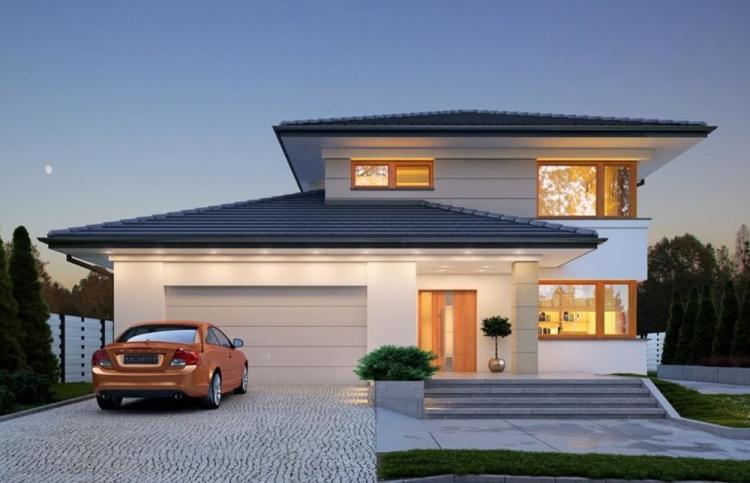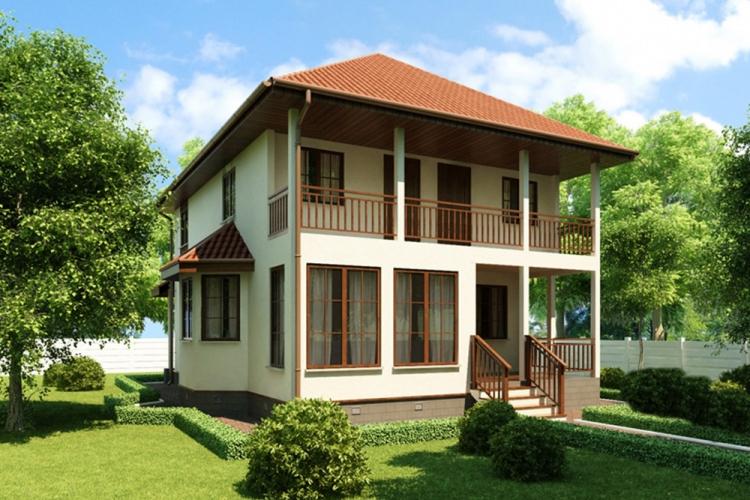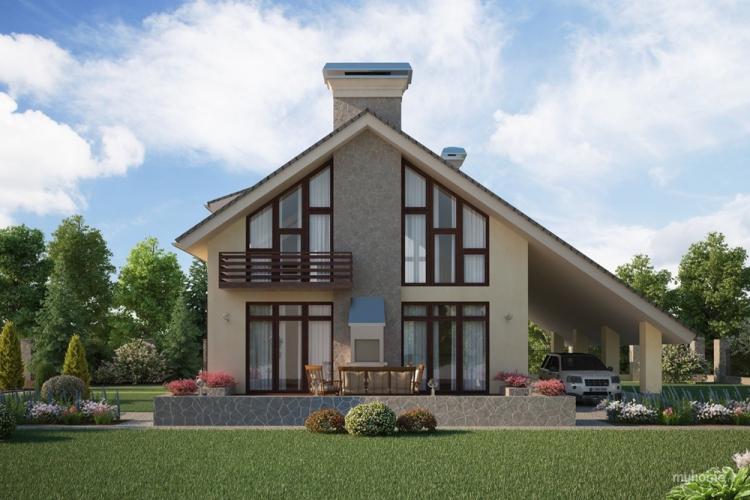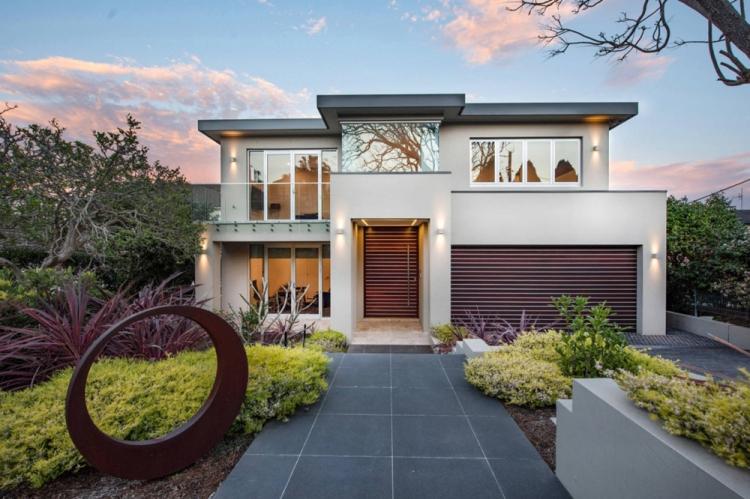- 1. Choosing building materials
- 2. Roof for a Two-Story House
- 3. Layout Options for a Two-Story House
-
4.
Two-Story Houses – Designs and Photos
- 4.1. Two-Story Brick House
- 4.2. Two-Story Timber House
- 4.3. Two-Story House with Garage
- 4.4. Two-Story House with a Balcony
- 4.5. Two-Story House with a Terrace
- 4.6. Two-Story House with Mansard Roof
- 4.7. Two-Story House with Flat Roof
- 4.8. Two-story house in Scandinavian style
- 4.9. Two-story house in chalet style
Planning to build your own cottage, but unsure which floor plan to choose and how to arrange all necessary rooms? Consider practical and convenient two-story homes. This is an excellent way to save space on your plot and use it for a garden, gazebo, playground, or pool. You will have more design and architectural ideas and, most importantly, the opportunity to furnish the attic!
Choosing building materials
When choosing materials for building a house, consider price, labor costs, insulation, and expenses for future finishes. Cold walls will cost you a lot in winter if you don’t take care of insulation, unlike warm walls. Smooth modern materials are easier to paint or cover from the outside, and this is also a cost-saving measure.
Traditional brick can last more than 100 years, is not afraid of heat and frost, and the installation technology is well-practiced. However, it requires a massive foundation due to its weight, and bricklaying will take time and investments. It is much easier and faster to work with ceramic blocks, but they are expensive and more fragile.

Gas-concrete and expanded clay-concrete blocks are a lightweight, practical, and warm material with a porous structure and high fire resistance. However, they have low bending strength and can crack over time. The closest alternative is more expensive but sturdy and load-resistant aerated concrete with high insulation properties.
Log houses are comfortable, environmentally friendly, always stylish and cozy. However, working with natural wood is difficult, you need to wait for shrinkage, protect it from moisture and pests. Building from a timber frame is easier and faster, but the main disadvantages still remain.
Different technologies of frame houses, houses made of SIP panels, and other prefabricated structures have proven to be good options. They are easy, fast, and practical, but there may be problems with individual planning. Another option for a two-story house is a combined technology, such as a wooden top on a stone foundation.

Roof for a Two-Story House
For a two-story house, all classic types of roofs are suitable: flat, single- and multi-sloped, gable and dome, hip and half-hip, conical, mansard, and combined. When choosing, consider the style of the house and the architectural project as a whole. For example, to arrange a living space in the attic, you need to plan for a mansard roof in advance.
Sheet roofing materials are characterized by ease of installation and quick laying, but they are not suitable for complex configurations. This includes very durable corrugated sheeting or metal tiles with a polymer coating, versatile and inexpensive asbestos-cement sheets, and lightweight and unpretentious Onduline.

Piece materials look more impressive and are suitable for roofs of any shape and configuration, but working with them is longer and more difficult. This includes unpretentious fire-resistant ceramic tiles, cheaper but heavy cement-sand tiles, elite slate, and durable but currently rare composites.
Soft bituminous coatings with increased thermal insulation properties are not afraid of fungi and ultraviolet radiation. The sheets are tightly fused, so they do not leak in winter or during heavy rain. They can even be laid on domed roofs. But it is crucial to follow the installation technology to avoid deforming the plates with a burner.


Layout Options for a Two-Story House
The classic layout of a two-story house involves placing all utility rooms on the first floor and living rooms on the second floor. For example, on the bottom floor, there can be an entrance hall, living room, kitchen, and dining room, while on the top floor there can be bedrooms, a children’s room, and a study.
The boiler room, pantry, and technical rooms are also located on the ground floor. It is more convenient to place bathrooms on both floors at once: for example, a guest bathroom with a shower on the bottom floor and a master bathroom with a bathtub on the top floor. If a garage or sauna is attached to the house, they are also included in the overall plan.

Two-Story Houses – Designs and Photos
Even typical two-story house projects vary in styles and configurations. Small elegant cottages are suitable for one or two people. And spacious mansions can become a real family nest for the entire family.
Two-Story Brick House
For construction, ceramic or silicate bricks are used. Ceramic bricks are made of fired clay, so it is completely ecological, does not burn and does not let water pass through. Silicate bricks contain sand and lime with additives, so it has a wider range of colors.
Both hollow and solid bricks are suitable for two-story cottages: the first is warmer, the second is stronger. Each series has its own frost resistance marked in the labeling, which should be higher for the foundation and basement. Note that two-story brick cottages require a strong foundation due to their weight.








Two-Story Timber House
Structural timber consists of smooth, even logs with precise geometric dimensions and various cross-sections, making it easier to work with than a log house, although it may not look as natural and impressive. Sawn timber is too wet and shrinks, so use planed or glued timber for houses.
Wood has better thermal conductivity than brick, creating a healthy microclimate in rooms. A wooden house doesn’t necessarily need finishing, as it’s already beautiful. However, treat wood with antiseptics and fire retardants, as it can crack and experience shrinkage for several years.










Two-Story House with Garage
To move the garage to a separate building, a large yard area is needed, which is not always feasible. If you attach it to the house, make sure it is soundproofed and has a uniform facade finish with the roof. Unlike the main building, it is better not to make the garage out of wood: wall panels are more suitable.
Most often, the garage has two entrances: to the street and to the house, and the second requires more careful organization. Make a separate corridor or vestibule between the utility and residential rooms so that no odors or cold air get into the room. Be sure to plan the roof configuration so that it is complete and harmonious.










Two-Story House with a Balcony
One of the main advantages of a two-story house is the possibility of adding a balcony. It is a decorative element of the facade, a great place to relax and enjoy nature, an extension of the functional living area, and an increase in the amount of light in the room.
Remember that a balcony is a hanging structure, so a large one needs extra support. Use special crosspieces and columns made of brick, wood, or reinforced concrete for this purpose. To protect the balcony from rain and sun, add a small canopy or pergola.










Two-Story House with a Terrace
A terrace serves as a versatile summer area for relaxation, dining, living, or a summer kitchen. In single-story houses, attach them to the bottom, while a two-story cottage allows for a second-floor terrace. This setup lets you enjoy picturesque views with a cup of coffee or glass of wine.
Terraces can be open, partially covered, or completely enclosed. Closed terraces, attached to the bottom, are usable year-round and can even be heated. People sometimes refer to large and spacious porches, balconies, gazebos, or verandas as terraces.










Two-Story House with Mansard Roof
A mansard roof of a two-story house can accommodate a lounge, guest room, office, gym, billiards room, home theater, or bedrooms with panoramic windows. The roofs are typically single-sloped, double-sloped, or broken. Note that the first floor of mansard-roofed houses is usually more massive than the second, as the structure gradually tapers upwards. Therefore, if you plan to have several rooms upstairs, you need to carefully consider the layout and calculate the load on the foundation, taking into account the total area of the cottage.








Two-Story House with Flat Roof
A flat roof looks stylish and modern on such two-story houses in contemporary style. It is a good option for regions with windy seasons and snowy winters. The roof covering will not suffer from wind loads, and snow will not accumulate on the surface. Another advantage of a flat roof is its functionality and the possibility of arranging additional space on top, such as a small terrace, a relaxation area, a small garden, or a greenhouse. But it is essential to select special covering and insulation, including hydro-insulation.










Houses in Scandinavian style are concise, minimalist, functional, and simple. Only natural materials are used for construction, as unity with nature is the main concept of northern traditions. Another mandatory requirement is energy efficiency, thanks to which it is comfortable inside both in hot summers and cold winters.
Among the pronounced visual features is the simplicity of the facade finishing without complex patterns and decorative elements. The finishing uses a concise and natural color scheme: black, white, brown, and rarely blue. The entire structure is a regular triangle with smooth walls and a two-slope shingle roof.










Two-story house in chalet style
Houses in chalet style embody romantic Alpine cottages, featuring a stone first floor and wooden second floor. They have a high two-slope roof extending beyond the facade, covered mansards, and large window openings with solid frames. Chalet-style houses are ideal for green hilly areas with an Alpine garden.
For construction, use strictly natural materials like logs, boards, and wooden panels. An affordable, low-maintenance, and moisture-resistant option is larch. The stone portion offers extra insulation and raises the house’s level, allowing for a basement or ground floor at the bottom.
















Leave feedback about this